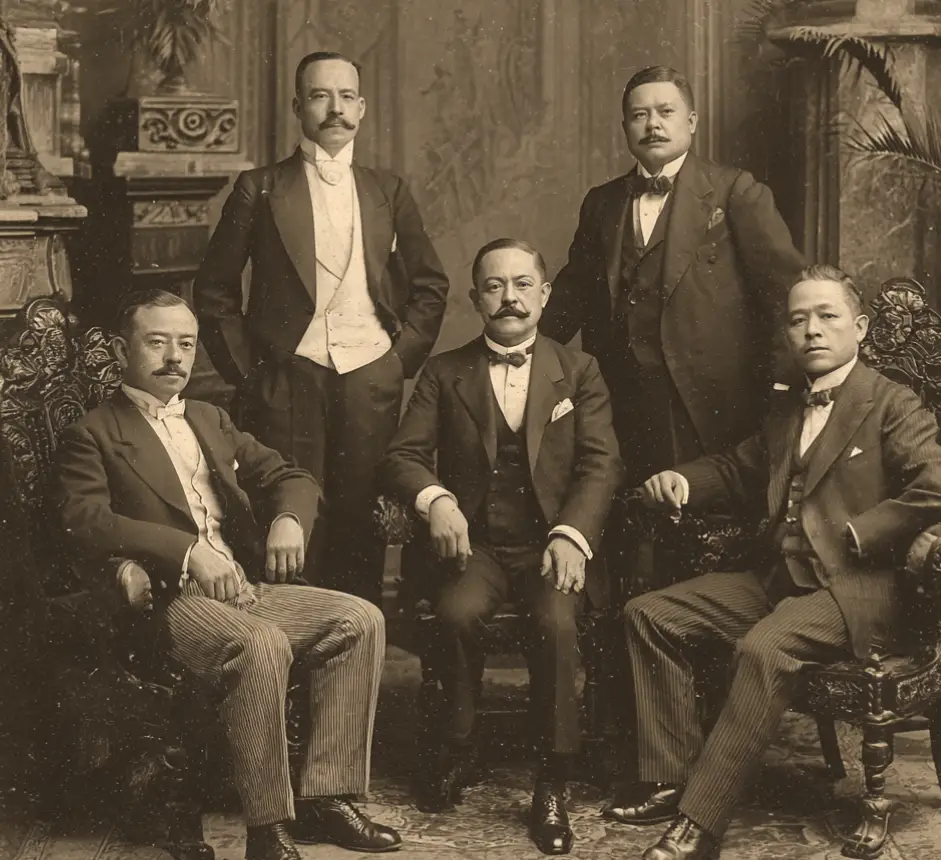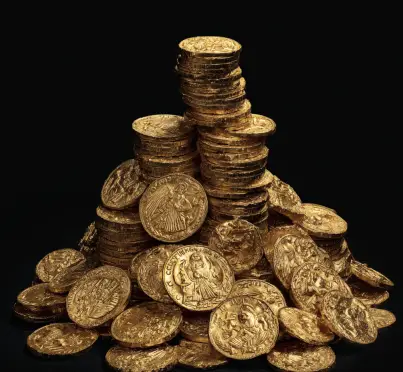Podcast: Play in new window | Download
Subscribe: Apple Podcasts | RSS
 In the vast, arid expanses of northwestern New Mexico, near the borders of the Navajo and Ute Indian Reservations, lies one of the American Southwest’s most enduring mysteries: the alleged burial site of nearly 16 tons of Mexican gold ingots. This story centers on Leon Trabuco, a businessman from Mexico said to have orchestrated a daring smuggling operation during the depths of the Great Depression. What began as a calculated gamble on rising gold prices devolved into a saga of legal pitfalls, untimely deaths, and fruitless searches that have captivated treasure hunters for decades. While the tale has been featured on television programs and in books, it straddles the line between historical intrigue and folklore, with scant verifiable records to confirm its core details.
In the vast, arid expanses of northwestern New Mexico, near the borders of the Navajo and Ute Indian Reservations, lies one of the American Southwest’s most enduring mysteries: the alleged burial site of nearly 16 tons of Mexican gold ingots. This story centers on Leon Trabuco, a businessman from Mexico said to have orchestrated a daring smuggling operation during the depths of the Great Depression. What began as a calculated gamble on rising gold prices devolved into a saga of legal pitfalls, untimely deaths, and fruitless searches that have captivated treasure hunters for decades. While the tale has been featured on television programs and in books, it straddles the line between historical intrigue and folklore, with scant verifiable records to confirm its core details.
The narrative unfolds against the backdrop of the early 1930s, a period of profound economic turmoil. The Great Depression, triggered by the 1929 stock market crash, had plunged the United States into widespread unemployment, bank failures, and deflation. Gold, long a symbol of stability, became a focal point of policy debates. In Mexico, the economic ripple effects were severe, with fluctuating currency values and restrictions on gold exports. It was in this environment that Trabuco, described in accounts as a wealthy rancher and miner from the Mexican state of Chihuahua, reportedly saw an opportunity. According to the legend, Trabuco assembled a group of four affluent partners: Guzman Morada, an economics professor at a Mexican university; Ricardo Arteaga, a rancher from Torreon; Carlos Sepulveda, another Chihuahua rancher; and Rafael Borreaga, an international banker with ties to Mexico and Spain. Together, they pooled resources to acquire vast quantities of Mexico’s gold reserves—coins, jewelry, and bullion—at depressed prices. Their plan was straightforward yet audacious: smuggle the gold into the United States, where they anticipated a devaluation of the dollar would drive up gold values, allowing them to sell at a massive profit.
 Over a span of less than three months in the summer of 1933, the group allegedly melted down their acquisitions into ingots at a makeshift foundry in the desert outside Chihuahua City, amassing nearly 16 tons of pure gold. This quantity was staggering; at the time, gold was valued at around $20 per ounce, making their hoard worth millions even before any price surge. To transport it across the border undetected, Trabuco enlisted an American pilot. This pilot has been identified in some sources as Red Moiser, a former World War I aviator and test pilot, and in others as Bill Elliot, possibly a pseudonym. The pilot made 16 covert flights in a small aircraft, such as a Cessna, each carrying one ton of ingots. These nighttime operations landed in the remote desert near Farmington, New Mexico, a sparsely populated area ideal for secrecy. Upon landing, the gold was reportedly unloaded onto pickup trucks and driven to a hidden burial site. Trabuco himself is said to have overseen the final concealment, burying the ingots deep in the ground without creating a map or sharing the exact location with his partners. The chosen spot was near the Ute and Navajo reservations, in a rugged terrain of mesas, canyons, and rocky outcrops that offered natural camouflage. The final shipment arrived on July 14, 1933, completing the operation without apparent detection by authorities. The group’s timing seemed perfect at first. On April 5, 1933, President Franklin D. Roosevelt issued Executive Order 6102, which prohibited the private hoarding of gold coins, bullion, and certificates in the United States, requiring citizens to surrender their holdings to the Federal Reserve in exchange for paper currency. This move was part of a broader effort to stabilize the banking system and combat deflation. Then, on January 30, 1934, Roosevelt signed the Gold Reserve Act, which revalued gold from $20.67 to $35 per ounce, effectively devaluing the dollar and boosting the potential value of Trabuco’s gold hoard by an estimated $7 million. However, this legislative shift proved disastrous for the smugglers. The Gold Reserve Act not only fixed the price but also made private ownership of significant gold quantities illegal, vesting title to all monetary gold in the U.S. Treasury. Suddenly, Trabuco’s treasure transformed from a lucrative investment into too-hot-to-handle contraband. Any attempt to sell it on the open market risked severe penalties, including confiscation and imprisonment. The U.S. Secret Service and Treasury Department viewed such smuggled gold as subject to import duties, with no statute of limitations, rendering it essentially worthless until laws changed.
Over a span of less than three months in the summer of 1933, the group allegedly melted down their acquisitions into ingots at a makeshift foundry in the desert outside Chihuahua City, amassing nearly 16 tons of pure gold. This quantity was staggering; at the time, gold was valued at around $20 per ounce, making their hoard worth millions even before any price surge. To transport it across the border undetected, Trabuco enlisted an American pilot. This pilot has been identified in some sources as Red Moiser, a former World War I aviator and test pilot, and in others as Bill Elliot, possibly a pseudonym. The pilot made 16 covert flights in a small aircraft, such as a Cessna, each carrying one ton of ingots. These nighttime operations landed in the remote desert near Farmington, New Mexico, a sparsely populated area ideal for secrecy. Upon landing, the gold was reportedly unloaded onto pickup trucks and driven to a hidden burial site. Trabuco himself is said to have overseen the final concealment, burying the ingots deep in the ground without creating a map or sharing the exact location with his partners. The chosen spot was near the Ute and Navajo reservations, in a rugged terrain of mesas, canyons, and rocky outcrops that offered natural camouflage. The final shipment arrived on July 14, 1933, completing the operation without apparent detection by authorities. The group’s timing seemed perfect at first. On April 5, 1933, President Franklin D. Roosevelt issued Executive Order 6102, which prohibited the private hoarding of gold coins, bullion, and certificates in the United States, requiring citizens to surrender their holdings to the Federal Reserve in exchange for paper currency. This move was part of a broader effort to stabilize the banking system and combat deflation. Then, on January 30, 1934, Roosevelt signed the Gold Reserve Act, which revalued gold from $20.67 to $35 per ounce, effectively devaluing the dollar and boosting the potential value of Trabuco’s gold hoard by an estimated $7 million. However, this legislative shift proved disastrous for the smugglers. The Gold Reserve Act not only fixed the price but also made private ownership of significant gold quantities illegal, vesting title to all monetary gold in the U.S. Treasury. Suddenly, Trabuco’s treasure transformed from a lucrative investment into too-hot-to-handle contraband. Any attempt to sell it on the open market risked severe penalties, including confiscation and imprisonment. The U.S. Secret Service and Treasury Department viewed such smuggled gold as subject to import duties, with no statute of limitations, rendering it essentially worthless until laws changed.
 Faced with this impasse, Trabuco and his associates reportedly decided to wait for a more favorable climate. But fate intervened cruelly. Within five years of the burial, three of the partners met untimely ends: Arteaga was gored by a fighting bull, Sepulveda perished in a car crash, and Morada and Borreaga succumbed to natural causes, though some accounts imply suspicious circumstances. The pilot, whether Moiser or Elliot, joined the U.S. Air Force and was killed in a bombing raid over Germany during World War II. Trabuco, the last survivor, explored black-market options, including contacts with a former Gestapo officer in Mexico and Swedish industrialist Axel Wenner-Gren. In 1941, he rejected an offer from a mysterious buyer named Ivan Nasicecu, who claimed to represent a European royal family, possibly the exiled King Carol II of Romania.
Faced with this impasse, Trabuco and his associates reportedly decided to wait for a more favorable climate. But fate intervened cruelly. Within five years of the burial, three of the partners met untimely ends: Arteaga was gored by a fighting bull, Sepulveda perished in a car crash, and Morada and Borreaga succumbed to natural causes, though some accounts imply suspicious circumstances. The pilot, whether Moiser or Elliot, joined the U.S. Air Force and was killed in a bombing raid over Germany during World War II. Trabuco, the last survivor, explored black-market options, including contacts with a former Gestapo officer in Mexico and Swedish industrialist Axel Wenner-Gren. In 1941, he rejected an offer from a mysterious buyer named Ivan Nasicecu, who claimed to represent a European royal family, possibly the exiled King Carol II of Romania.
By 1952, Trabuco attempted a discreet deal with the U.S. government, but this drew scrutiny. A federal grand jury investigated the group for conspiring to purchase and resell Mexico’s gold reserves illegally. Although no indictments were issued, the stress may have contributed to Trabuco’s death shortly thereafter. On his deathbed, he is said to have whispered that “the gold is only a few miles from a major New Mexico landmark,” but provided no further details. With his passing, the secret of the burial site appeared lost forever.
 The story might have faded into obscurity if not for the efforts of treasure hunters who latched onto its allure. The most prominent among them was Ed Foster, a dedicated searcher who devoted over 35 years to unraveling the mystery. Foster focused his hunts around Farmington, New Mexico, piecing together clues from local oral histories. He interviewed Navajo residents who recalled unusual events in 1933: a young girl, then about six years old, remembered seeing a plane landing and taking off repeatedly in the desert. Another woman described spotting well-dressed Mexican men on the reservation, an anomaly in that era.
The story might have faded into obscurity if not for the efforts of treasure hunters who latched onto its allure. The most prominent among them was Ed Foster, a dedicated searcher who devoted over 35 years to unraveling the mystery. Foster focused his hunts around Farmington, New Mexico, piecing together clues from local oral histories. He interviewed Navajo residents who recalled unusual events in 1933: a young girl, then about six years old, remembered seeing a plane landing and taking off repeatedly in the desert. Another woman described spotting well-dressed Mexican men on the reservation, an anomaly in that era.
Foster identified Conger Mesa as a likely landing strip for the flights, a flat plateau suitable for small aircraft. About 20 miles west, he discovered an old structure resembling a Mexican-style home with windows, doors, and a veranda—uncommon on Navajo land—which he believed served as a guard post for the operation. Nearby stood Shrine Rock, a natural formation etched with the inscription “1933 sixteen ton,” which Foster interpreted as a marker left by the smugglers. These elements formed what he called the “Conger Mesa Treasure Triangle,” bounded by the mesa, the rock, and the house. He scoured the area with metal detectors and his own eyes, convinced the gold lay buried there.
Foster’s quest gained credibility when he enlisted Norman Scott, a renowned treasure hunter known for his work on other lost fortunes. Scott surveyed the site and remarked that the story had “a ring of authenticity to it,” suggesting that modern technology—beyond mere luck—could eventually uncover the hoard. Despite these efforts, no gold was ever found. Foster’s searches continued into the late 1980s and beyond, but he passed away without success.
 The legend received wider exposure through media. In 1991, the television show Unsolved Mysteries aired a segment on the Trabuco treasure, dramatizing the smuggling and Foster’s hunts. This episode sparked renewed interest, leading to books like The Hidden Gold of Leon Trabuco by an anonymous author, which frames the story as a true conspiracy involving betrayal and adventure. Online forums, such as Reddit, have debated its veracity, with users pointing out inconsistencies: the lack of historical records for Trabuco or Moiser in this context, the questionable authenticity of the Shrine Rock carving (noting “ton” is an English word, not Spanish), and the secrecy surrounding the 1950s grand jury. Many dismiss it as a hoax or tall tale, akin to other Southwestern legends, while others argue the circumstantial evidence from Navajo witnesses lends plausibility.
The legend received wider exposure through media. In 1991, the television show Unsolved Mysteries aired a segment on the Trabuco treasure, dramatizing the smuggling and Foster’s hunts. This episode sparked renewed interest, leading to books like The Hidden Gold of Leon Trabuco by an anonymous author, which frames the story as a true conspiracy involving betrayal and adventure. Online forums, such as Reddit, have debated its veracity, with users pointing out inconsistencies: the lack of historical records for Trabuco or Moiser in this context, the questionable authenticity of the Shrine Rock carving (noting “ton” is an English word, not Spanish), and the secrecy surrounding the 1950s grand jury. Many dismiss it as a hoax or tall tale, akin to other Southwestern legends, while others argue the circumstantial evidence from Navajo witnesses lends plausibility.
Skeptics highlight broader doubts. Archival searches in newspapers like the Albuquerque Journal and Santa Fe New Mexican confirm the economic policies of the era but yield no direct mentions of Trabuco or his partners. The story bears similarities to fictionalized accounts in books by authors like W.C. Jameson, who penned New Mexico Treasure Tales, raising questions about whether the Trabuco gold story is rooted in fact or embellished folklore. Moreover, the Navajo Nation’s land restrictions complicate modern searches; digging requires tribal approval, and unauthorized efforts risk arrest.
Yet, the allure persists. If the gold exists, its value today—adjusted for inflation and current market prices exceeding $2,500 per ounce—could surpass $1 billion, making it one of the largest lost treasures in American and Mexican history. In 1974, President Gerald Ford signed legislation repealing the Gold Reserve Act’s prohibitions, legalizing private gold ownership once more. This change theoretically restored the hoard’s worth, but without a map or definitive clues, it remains elusive. Variations in the tale add layers of intrigue. Some accounts place the burial near Shiprock Peak or along Route 504, based on alternative witness reports. Others speculate government involvement, suggesting the U.S. Treasury might have quietly recovered the gold during the 1940s investigations. Conspiracy theories even link it to wartime espionage, given Trabuco’s alleged contacts with Axis sympathizers. Some also believe that one of Trabuco’s relatives knew of the hoard’s exact location and secretly took the gold back to Mexico many decades ago.
 Treasure hunting in the Southwest has a storied history, from the Lost Dutchman’s Mine in Arizona to Montezuma’s Aztec gold purportedly hidden in Utah. The Trabuco legend fits this mold, blending economic opportunism with the romance of buried riches. For locals in Farmington, it’s a point of quiet pride and occasional tourism draw, though few take metal detectors to the mesas in earnest. As of 2025, no credible discovery has been reported. Drones, ground-penetrating radar, and satellite imagery offer new tools for searchers, but the desert’s vastness and the story’s many ambiguities deter even the most die-hard treasure hunters. Whether Leon Trabuco’s gold is a genuine historical truth or a Depression-era myth, it endures as a testament to human ambition and the unpredictable twists of fortune. In the words of one skeptic on social media, it might be “a wild goose chase,” but for believers, the next shovel strike could unearth a fortune.
Treasure hunting in the Southwest has a storied history, from the Lost Dutchman’s Mine in Arizona to Montezuma’s Aztec gold purportedly hidden in Utah. The Trabuco legend fits this mold, blending economic opportunism with the romance of buried riches. For locals in Farmington, it’s a point of quiet pride and occasional tourism draw, though few take metal detectors to the mesas in earnest. As of 2025, no credible discovery has been reported. Drones, ground-penetrating radar, and satellite imagery offer new tools for searchers, but the desert’s vastness and the story’s many ambiguities deter even the most die-hard treasure hunters. Whether Leon Trabuco’s gold is a genuine historical truth or a Depression-era myth, it endures as a testament to human ambition and the unpredictable twists of fortune. In the words of one skeptic on social media, it might be “a wild goose chase,” but for believers, the next shovel strike could unearth a fortune.
REFERENCES
Jameson, W.C. New Mexico Treasure Tales. Caldwell, ID: Caxton Press, 2003. Buy the book on Amazon here: https://amzn.to/4rgcZ1l
Unsolved Mysteries, Season 4.
